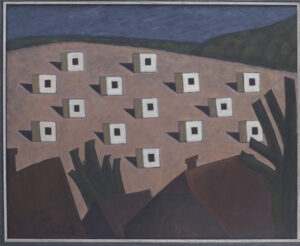Meaning ‘to return to one’s country’, repatriation stems from the Latin re- (‘back’) and patria (‘fatherland’). As patria ultimately derives from pater (‘father’), ‘repatriation’ shares a common root with other terms connoting national, familial, and social structures, such as patriotism, patriarch, patrimony, compatriot, and more.
‘Repatriation’ is used to denote processes of ‘return’ of many sorts: those pertaining to humans (living or deceased), objects, as well as taonga (or ‘treasures’) and other sites of tangible or intangible value.[1] In terms of human migration, ‘repatriation’ is used in reference both to voluntary return and involuntary deportation. The remains of those recently or long-deceased may also be repatriated to their ancestral lands. Finally, culturally significant material such as artwork, monuments, regalia, and grave goods may be repatriated following its expropriation under conditions of social or political duress.[2]
Due to the colonial origins of numerous Western museum collections, many nations and communities from which such collections originated have undertaken sustained campaigns for the repatriation of human remains and cultural patrimony, the most well-known of which include the ‘Elgin’ or Parthenon Marbles, the Benin Bronzes, and the Bust of Nefertiti. But the implications of repatriation extend beyond mere property rights: as Felwine Sarr and Bénédicte Savoy argue in a recent landmark report, “it’s a way to open a pathway toward establishing new cultural relations based on a newly reflected upon ethical relation.”[3]
As a result of such efforts, repatriative campaigns have gained increasing international support since the 1960s with the aid of international bodies such as the United Nations Educational, Scientific and Cultural Organization (UNESCO). But despite the institution of two conventions on the topic, most associated legal frameworks have failed to resolve previous claims to expropriated cultural property, focusing instead on the prevention of ongoing theft and illegal export.[4] Nevertheless, members of currently and formerly colonized nations have effected concrete legislative changes, including the institution of the Native American Graves Protection and Repatriation Act (NAGPRA) in 1990 in the United States as a result of protests led by Maria Pearson and others.[5]
While many such repatriation campaigns have been undertaken as part of a decolonial praxis, repatriation as a strategy has also been the subject of decolonial critique. For example, anthropologist Paul Basu suggests instead an “object diaspora” approach, one capable of “opening up and widening so-called ‘remittance corridors,’ […] channels through which economic capital can be encouraged to flow” back to its home community.[6] Other scholars such as Laura Peers and Alison K. Brown have suggested methods of ‘visual repatriation’, “in which images of ancestors, historical knowledge, and museum artefacts are returned to source communities,” rather than the discrete objects they represent.[7] Unangax scholar, Eve Tuck challenges ‘repatriation’ as a term for “reifying heteropatriarchal dominance,” suggesting instead a language of ‘rematriation’ that re-centers matrilineal epistemologies, and prioritizes “returning human remains and funerary objects to the earth.”[8] Seen as part of this broader set of strategies, repatriation might be understood as one form through which repair and return are endeavored, a means to mend living networks of geography, nation, and kin.
Notes
[1] James A.R. Nafziger and Ann M. Nicgorski. Cultural Heritage Issues: The Legacy of Conquest, Colonization, and Commerce. Cultural Heritage Issues (Leiden: Martinus Nijhoff Publishers, 2009), 107–134.
[2] For what defines duress under imperialism, and its blindspots, see Ariella Aïsha Azoulay, Potential History: Unlearning Imperialism (London: Verso, 2019) and Ann Laura Stoler, Duress: Imperial Durabilities in Our Times (Durham, NC: Duke University Press, 2016).
[3] Felwine Sarr and Bénédicte Savoy, “The Restitution of African Cultural Heritage: Toward a New Relational Ethics,” (Paris: Ministère de la Culture, 2018), 29.
[4] Dalia N. Osman, “Occupiers’ Title to Cultural Property: Nineteenth-Century Removal of Egyptian Artifacts.” Columbia Journal of Transnational Law 37, no.3 (1999), 971.
[5] Sangita Chari and Jaime M. N. Lavallee, Accomplishing NAGPRA : Perspectives on the Intent, Impact, and Future of the Native American Graves Protection and Repatriation Act (Corvallis: Oregon State University Press, 2013), 214
[6] Paul Basu, “Object Diasporas, Resourcing Communities: Sierra Leonean Collections in the Global Museumscape.” Museum Anthropology 34, no.1 (2011), 29.
[7] Laura Peers and Alison K. Brown. “Introduction.” In Museums and Source Communities: A Routledge Reader, edited by Laura Peers and Alison K. Brown, 1–16. (London and New York: Routledge, 2005), 14..
[8] Eve Tuck, “Rematriating Curriculum Studies.” Journal of Curriculum and Pedagogy 8, no.1 (2011), 35.
About the author
Pansee Abou ElAtta is an Egyptian-Canadian visual artist, curator, and doctoral researcher living and working on the unceded territory of the Algonquin Anishnaabe nation in Ottawa. Her practice centers grassroots responses to colonial projects of collection, display, and study. Previous exhibitions have taken place in collaboration with SAW Video in Ottawa, at Galerie La Centrale Powerhouse and Z Art Space in Montréal, the Art Gallery of Mississauga, and other contemporary Canadian arts spaces. Her curatorial work includes UTOPIAS, a collaborative, community-based performance art festival in Kingston, Ontario, and Home/Making, an exhibition at the Canada Council Art Bank.





